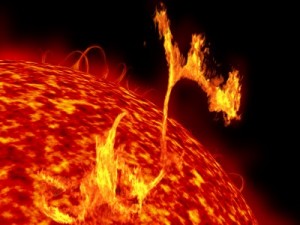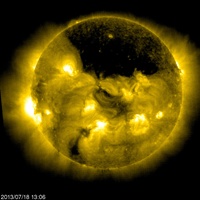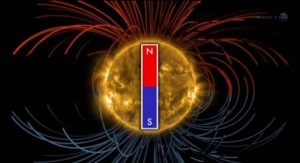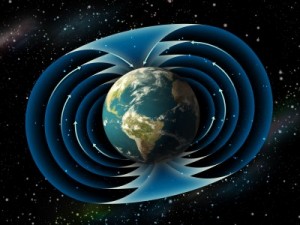
Solar flares, or CMEs, exploding off the surface of the Sun are quiet right now.
There appears to be a connection between solar storms and earthquakes. It might be a coincidence, but then again, I don’t believe in coincidence.
When the Sun fires off huge coronal mass ejections (CMEs), earthquake records show that an increase in earthquakes occur at the same time all over the world.
The Sun is very calm right now, and is not throwing out as many massive CMEs; the “number” of earthquakes worldwide is also down.
Coincidence? Nah – not with Nature.
The Eye Of A Solar Storm

This coronal hole on the Sun is moving toward its North Pole. This shows movement toward an upcoming reversal of the Sun’s magnetic poles – NASA.
Right now, the solar CME cycle appears very calm. This does not mean that the current “solar cycle” is over, by any means. Actually, the present solar cycle peaks in 2013, so if anything, this means that the Sun is “sucking up” more energy from its surface as its magnetic poles prepare to flip.
Compare this to the eye of a hurricane; the eye is the center of the storm, and it is calm, quiet, sunny, and still. When you come out of the eye into the backside of the storm, you are back to hurricane winds.
No one really knows for sure, but monitoring the Sun’s polar magnetic flip should provide some hints when the CMEs will start flaring up again.
Maybe a decrease in the number of earthquakes mirrors a upcoming reversal of the Earth’s magnetic poles. No one knows because human technology was not on Earth when this happened last.
EQs
At this time, there has been a decrease in the number of earthquakes, worldwide, but an increase in magnitude – the quakes that have occurred have been doozies.
The following large earthquakes (5.0 and above) have occurred worldwide over the past 7 days:
- 5.6 Carlsberg Ridge (Indian Ocean near equator)
- 7.7 Pakistan
- 5.9 Pakistan
- 5.0 Pakistan
- 5.6 Pakistan
- 3 islands formed in the Arabian Sea off the coast of Pakistan after these quakes
- 5.0 Pakistan
- 5.5 Pakistan
- 5.0 Pakistan
- 5.5 Tonga
- 5.4 East Pacific Rise (South Polar region)
- 5.4 Alaska (North Polar region)
- 7.0 Peru (equator)
- 5.4 Reykjanes Ridge, Iceland (North Polar region)
- 5.7 Mexico (equator)
- 5.0 Tonga
- 5.0 Pakistan
- 5.2 Russia (North Polar region)
- 5.4 North Mid-Atlantic Ridge (North Polar region)
- 6.8 Pakistan
- 5.7 Tonga
- 5.0 South Mid-Atlantic Ridge (South Polar region)
- 5.7 Tonga
- 5.0 South Mid-Atlantic Ridge (South Polar region)
- 5.0 New Guinea
- 5.2 Russia (North Polar region)
- 5.1 SW Indian Ridge
- 5.2 Chile
- 5.0 Chile
- 6.5 New Zealand
- 5.4 Mid Atlantic Ridge
- 5.0 New Guinea
- 5.0 Japan
Believe it or not, 33 earthquakes 5.0 and above is a decrease in the number of recent earthquakes, but the strength of the quakes is the difference – their magnitudes are increasing. Merely a decade ago, the list above would have been for the entire year. Today, these large quakes are occurring within a week.
As the solar cycle recharges, we’ll have to wait and see if this list increases in both number and magnitude.




